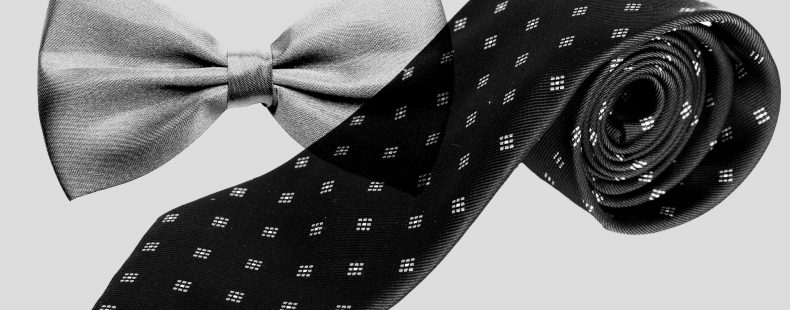⚡ Quick summary
The terms black tie and white tie refer to formal dress codes. Black tie is slightly less formal, typically allowing men to wear tuxedos or dinner jackets and women to wear cocktail dresses and long dresses. White tie is the most formal of all dress codes, requiring men to wear white bow ties and black tailcoats and women to wear evening or ball gowns.
At some point, you may have been to a black tie event if you’ve attended a fancy wedding. But what the heck is white tie? Is it more formal than black tie?
In this article, we will get all dressed up as we break down the differences between black tie and white tie, explain which is considered to be more formal, and give examples of clothing that is considered acceptable to wear for each category.
white tie vs. black tie
The terms black tie and white tie refer to formal dress codes worn at events such as weddings, galas, and dress parties. The terms refer to the black and white bow ties that are required to be worn by men as part of the two dress codes. Despite being named for men’s attire, black tie and white tie events also have dress codes for women’s attire.
Of the two, black tie is the less formal. However, black tie is typically the most formal attire that an average person is ever likely to wear. Women have several options to choose from for black tie attire: a floor-length dress or gown, a cocktail dress that at least reaches the knee, or a formal suit with trousers. Jewelry should be modest, not ostentatious or flashy. Besides the black bow tie, men typically wear a tuxedo or a dress suit consisting of a dinner jacket and dress pants. Either choice is accompanied by a white collared dress shirt and black leather dress shoes. For colors, men typically wear black jackets, although dark blues or gray are also common choices. Women are usually free to wear any reasonable color of dress they like, but it is strongly recommended not to wear white when attending a wedding.
White tie is considered to be the most formal dress code, typically reserved for the most formal occasions like royal galas or extremely prestigious parties where only royalty, politicians, and celebrities are ever invited. Because of this, the term white tie is much less commonly used and is why black tie is usually considered to be the most formal dress code that matters to “regular” people (who will never attend a white tie event).
As expected from the most formal dress code, white tie attire is very strict. For women, the only acceptable option is a floor-length evening or ball gown. Long white gloves are also traditional but not required, and ostentatious jewelry is acceptable. The white tie dress code for men is extremely strict and must consist of a hand-tied white bow tie, a white evening shirt, an untucked low-cut white waistcoat that leaves the shirt visible, a black unbuttoned evening tailcoat, mother-of-pearl cufflinks, black trousers with suspenders, and polished black leather pump shoes with black ribbons and black evening socks. Men may optionally accessorize their attire with a top hat, white gloves, and a dress cane.














